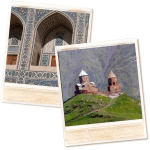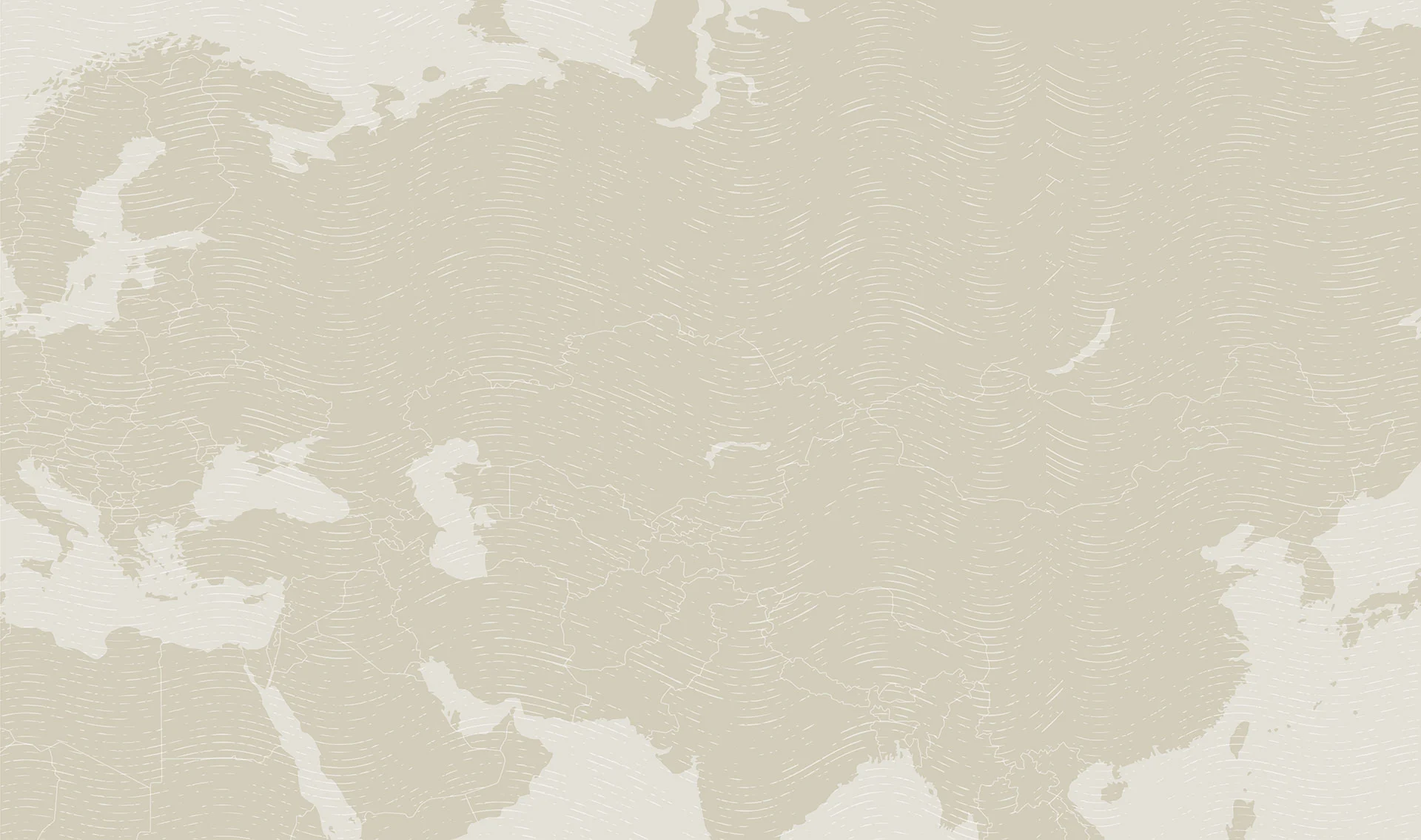What to Know Before Visiting Oman During Ramadan
A Journey Through the Land of Frankincense
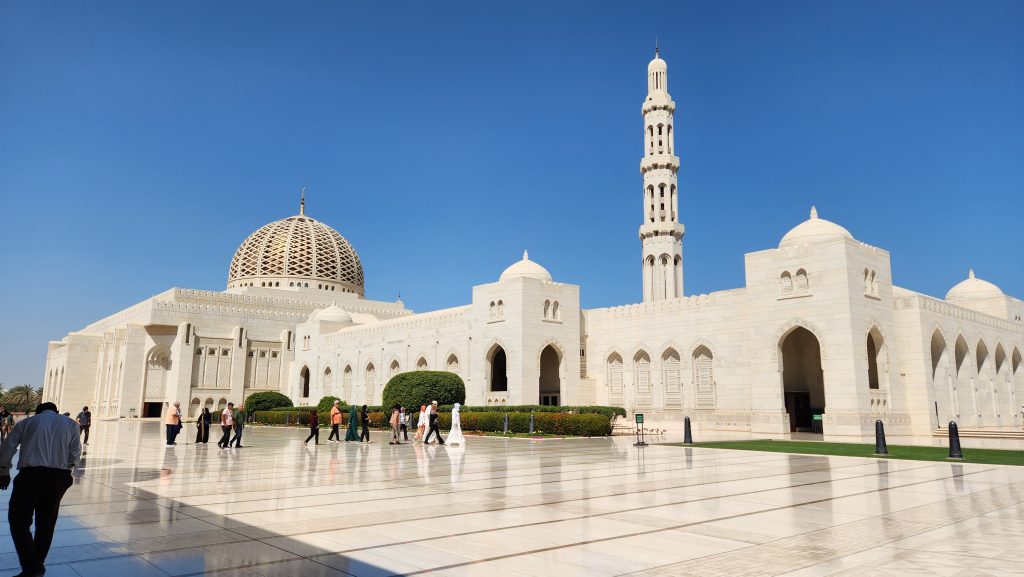
Ramadan, the ninth month of the Islamic calendar, is a sacred time for Muslims worldwide, a time of fasting, prayer, reflection, and community. From dawn to sunset, those observing the fast refrain from eating, drinking, and smoking, avoiding expressing anger or engaging in idle talk as part of spiritual discipline. As night falls, the energy shifts – families and friends gather for iftar, the meal that breaks the fast, and the streets come alive with food stalls, markets, and social gatherings.
For travelers, visiting Oman during Ramadan offers a different pace. The country slows down during the day, with many restaurants and businesses closed or operating on reduced hours. However, evenings bring a lively atmosphere, where visitors can witness local traditions up close. With fewer travelers, it is also a rare opportunity to explore Oman’s stunning landscapes and historic sites without crowds.
I recently traveled to Oman during Ramadan. While some might hesitate to visit during this time, the coming decade will see Ramadan shift into the fall and winter months – one of the best times to explore Oman. With cooler temperatures and fewer visitors, this period allows for a comfortable and immersive journey. Read about my recent adventure to Oman during Ramadan to discover everything you need to know about visiting at this special time of year.
Muscat – Markets, Mosques, and a Touch of Wellness
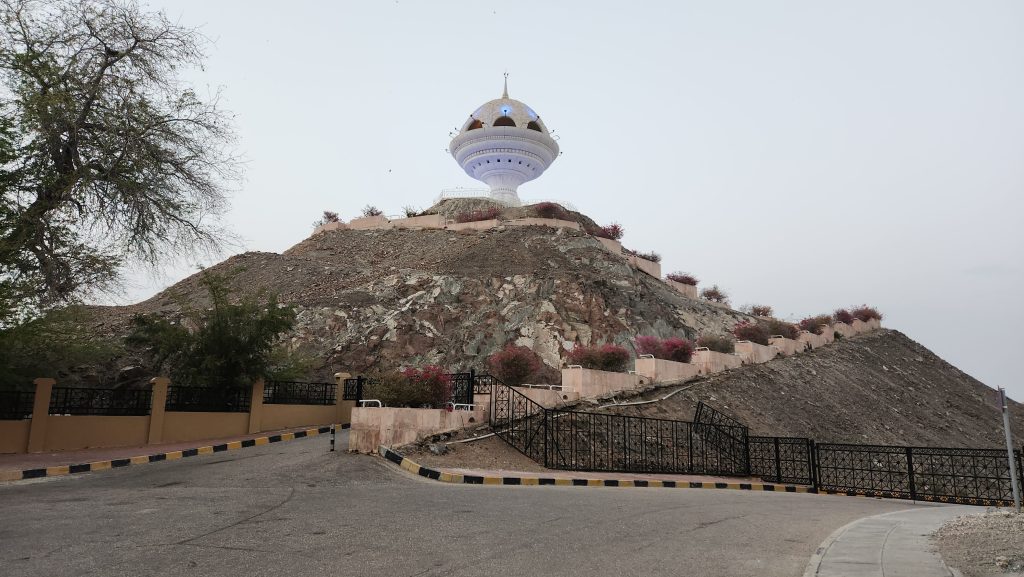
Our journey began in Muscat, where the contrast between quiet days and dynamic evenings was striking. It felt like two different cities depending on the time of day. During daylight hours, the streets were quiet, and the usual hustle of the souqs was subdued. But as soon as the call to prayer signaled the end of the fast, everything changed.
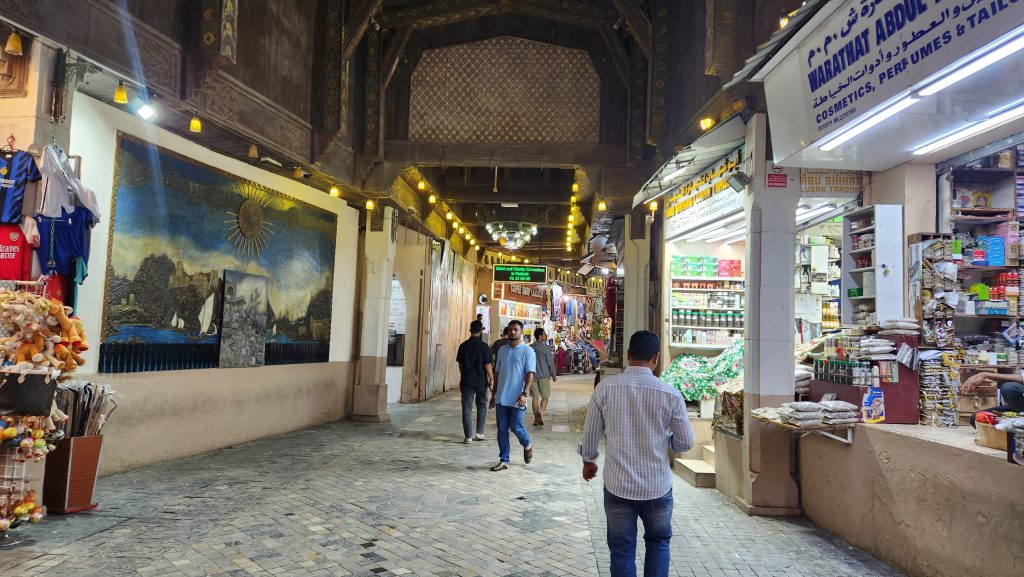
The Mutrah souq, which had been still in the afternoon, was now buzzed with activity. Merchants displayed spices, essential oils, fabrics, frankincense – an aromatic resin deeply tied to Omani heritage, myrrh, Oud (agarwood), rose water distilled from Damascus roses grown in the Jebel Akhdar mountains, and handcrafted souvenirs.
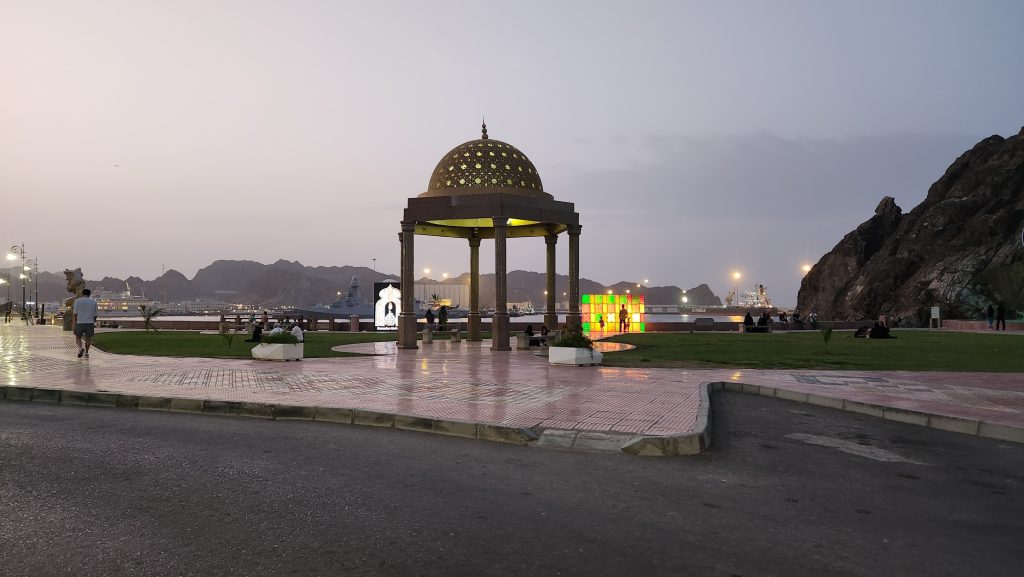
The scent of frankincense and Oud filled the air as locals walked along the Mutrah Corniche, sipping karak tea (milk tea) and Omani coffee. Families gathered in public parks decorated with glowing lights, while children played under lantern-lit palm trees. Restaurants were opened for iftar buffets offering traditional sweets like lokaimat, dates stuffed with nuts, and Omani halwa, and open-air cafes filled with people enjoying the evening. The atmosphere remained festive until suhoor, the pre-dawn meal before fasting resumed.
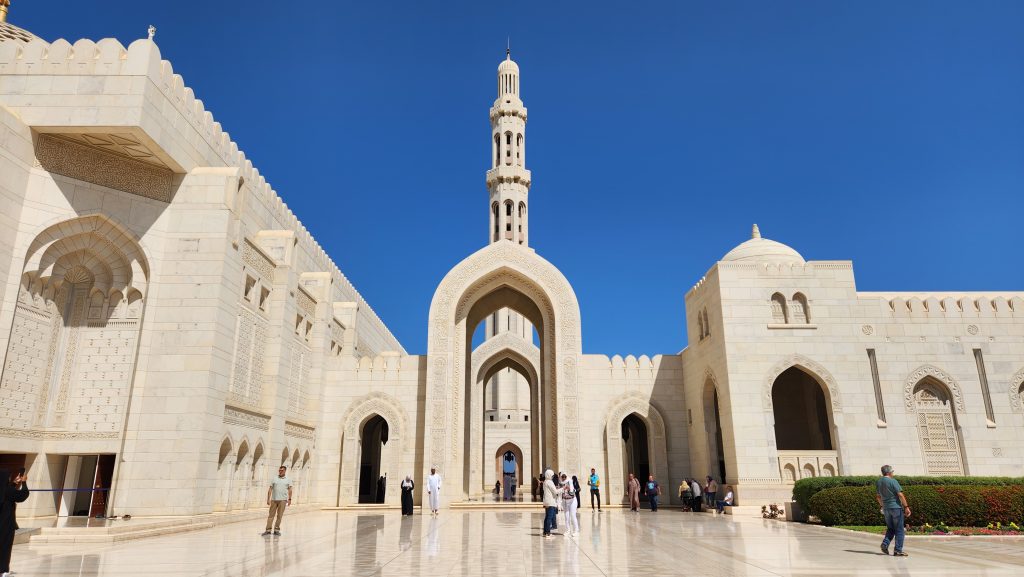
One of the highlights of our time in Muscat was visiting the Sultan Qaboos Grand Mosque, an architectural masterpiece with its enormous prayer hall, crystal chandelier, exquisite wood and tilework, vast carpet with matched patterns, colorful, tall windows and masterfully incorporated practical elements like air conditioning system that was blending with the interior made it one of the most impressive Islamic architectural sites in the region.
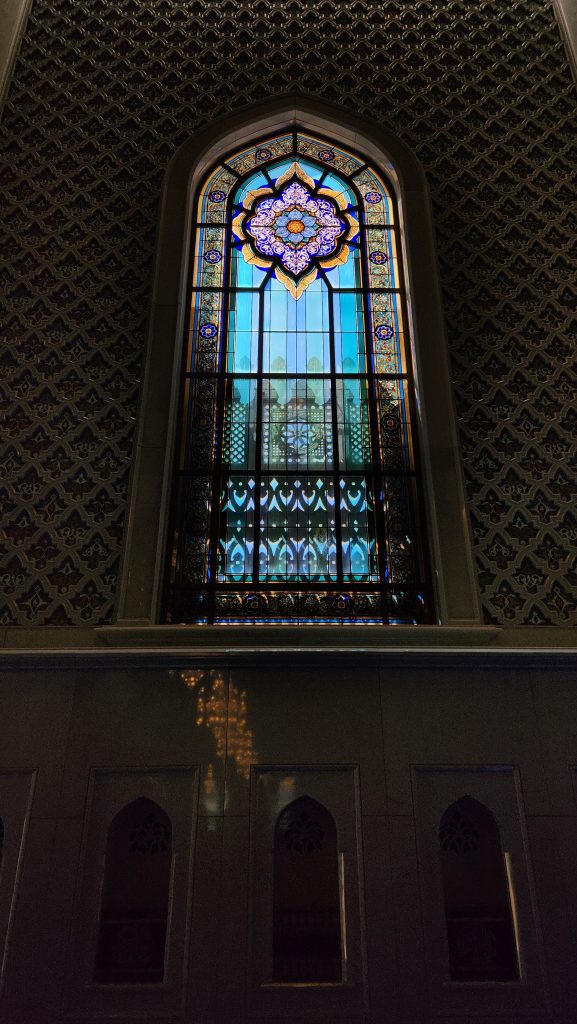
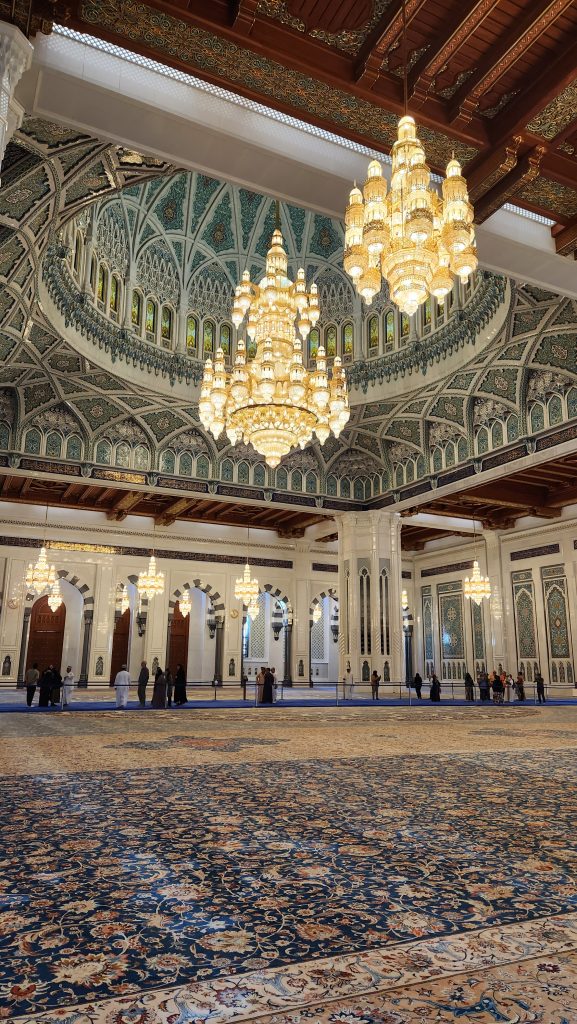
Officially, the mosque is open to non-Muslim visitors until 11 AM, but visitors were not rushed out, and the atmosphere remained welcoming. The dress code is enforced – women must cover their hair and shoulders, and both – men and women should wear long clothing. Outside religious sites, dress expectations are more relaxed, but wearing long pants or skirts in public is considered respectful.
Muscat is also a city that values wellness. Many hotels include full spa treatments, with saunas, steam baths, and massage treatments that use locally sourced essential oils. Frankincense and Oud permeated the air in hotel lobbies, and even the airport had diffusers releasing their scent.
Nakhal Fort, Nizwa, and the Timeless Villages of Bald Sayt, and Misfat Al Abriyeen and the Gem of Al Hamra Town.
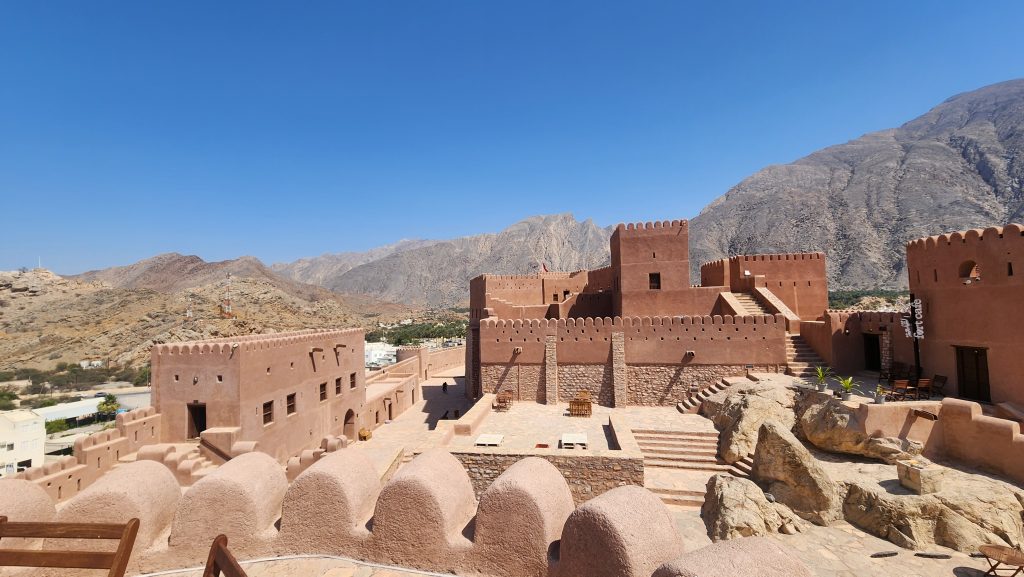
After leaving Muscat, we headed toward Nakhal Fort, a historic stronghold that stood almost empty – one of the advantages of traveling during Ramadan. The road from Muscat to Nakhal Fort resembles the smooth highways of Arizona, with scenic wadis and the added distinction of crossing the Tropic of Cancer (the northernmost latitude where the sun appears directly overhead at certain times of the year). The earthy brown hues of the fortress blend into the surrounding landscape, creating a tranquil atmosphere. Inside, exhibits displayed traditional Omani weaponry, date syrup extraction methods, folk medicine, and examples of local artistry. During Ramadan, Nakhal Fort is nearly empty – you may have this historic site all to yourself.
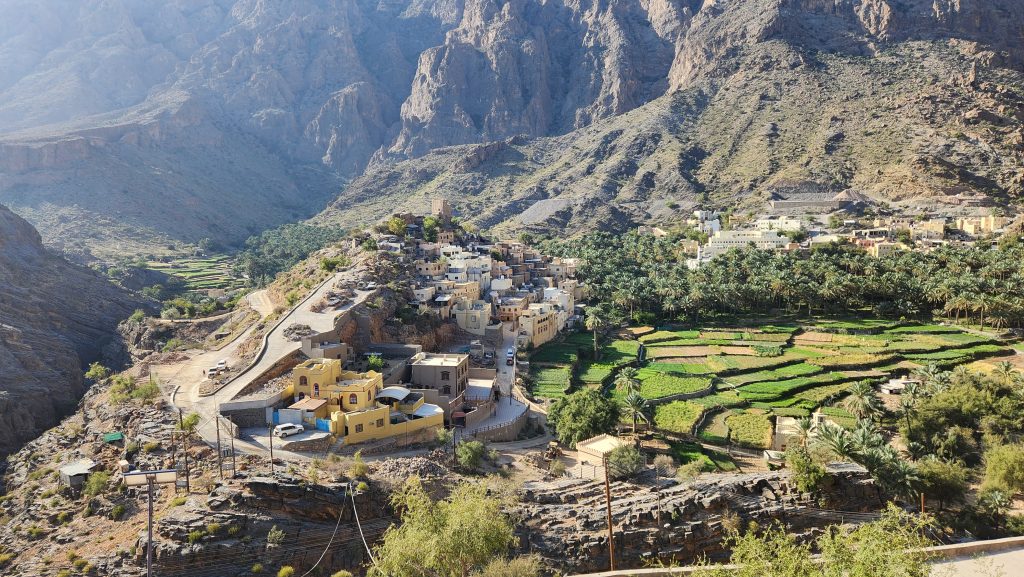
From Nakhal fort we continued to Al Hajar Mountains to visit Bald Sayt (Bilad Sayt), a truly off-the-beaten-path village. Life here moves at an even slower pace during Ramadan, untouched by modern distractions. Terraced gardens, traditional houses, and peaceful surroundings make a visit unforgettable. From the porch of our hotel, overlooking the entire village, the only sounds were chirping birds, the occasional bleating of wild goats, and quiet conversations among locals enjoying the cool evening air after iftar.
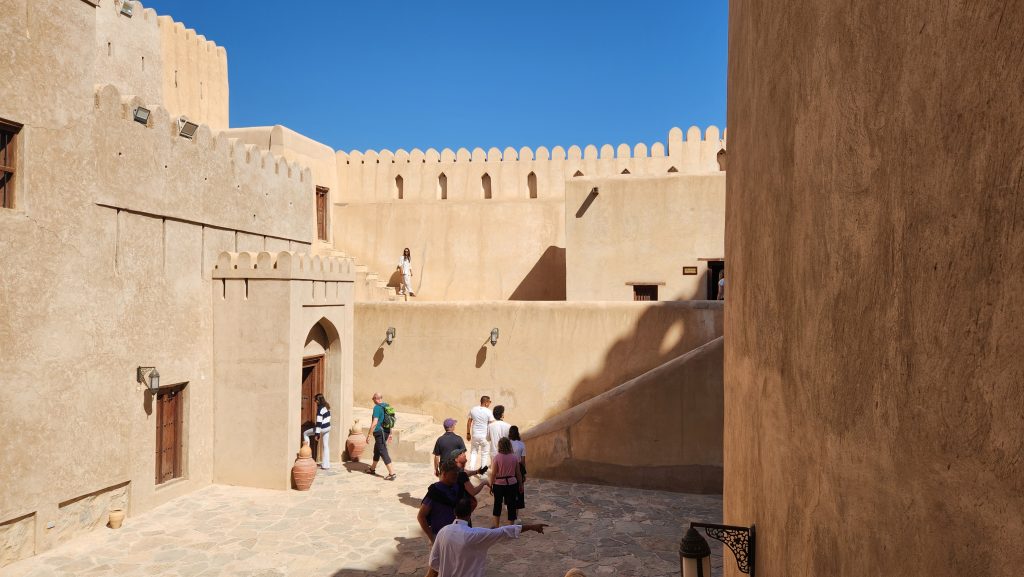
From Bald Sayt, we continued to Nizwa, famed for its massive fort and charming souq. The city, once the capital of Oman, remains one of its most historically rich destinations. In Nizwa city there are many Falajs (irrigation systems), among them Falaj Daris and Al Khatmain have been listed by UNESCO as world heritage sites. These Falajs irrigate palm trees that surround the area. Nizwa Fort, a UNESCO-listed site, is one of the most well-preserved in Oman.
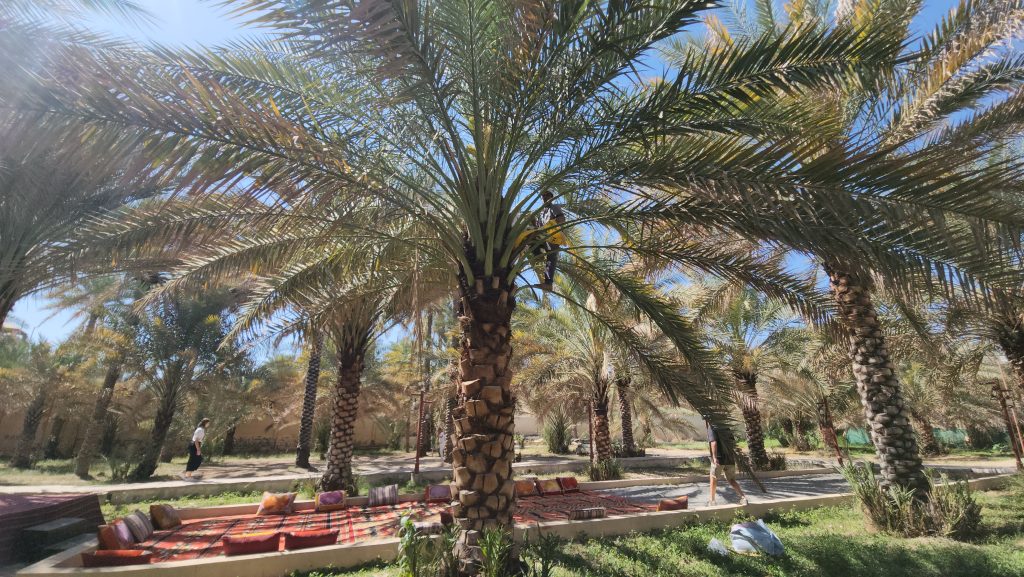
It is located in the heart of the city next to Harat Al-Aqer, an archeological site, estimated to be more than 1400 years old. The fort that once served as a defensive stronghold, took about 12 years to build. It has a height of about 78 feet and a diameter of about 131 feet. One of the fort’s defensive mechanisms contains hot date syrup sumps, that are equipped and prepared to deter enemies. The benefits of visiting during Ramadan became apparent – without the usual crowds, exploring the historic fortress and souq was a serene experience.
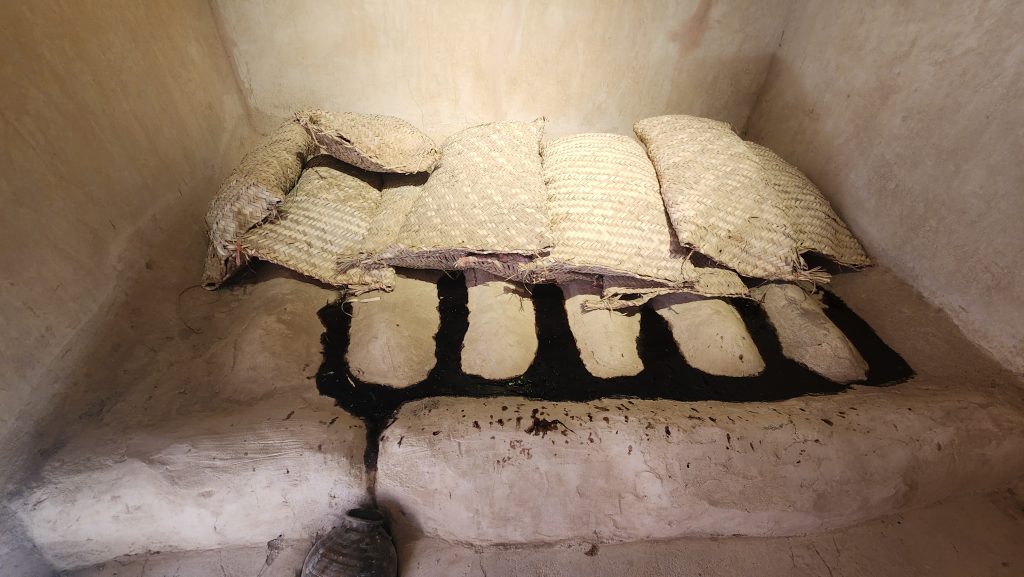
The Nizwa souq, known for its traditional pottery, khanjars (Omani daggers), and local spices, extended beyond the main market area to streets lined with vendors selling different kinds of nuts, herbs, and fragrant blends from Yemen, India, Pakistan, and other Asian countries.
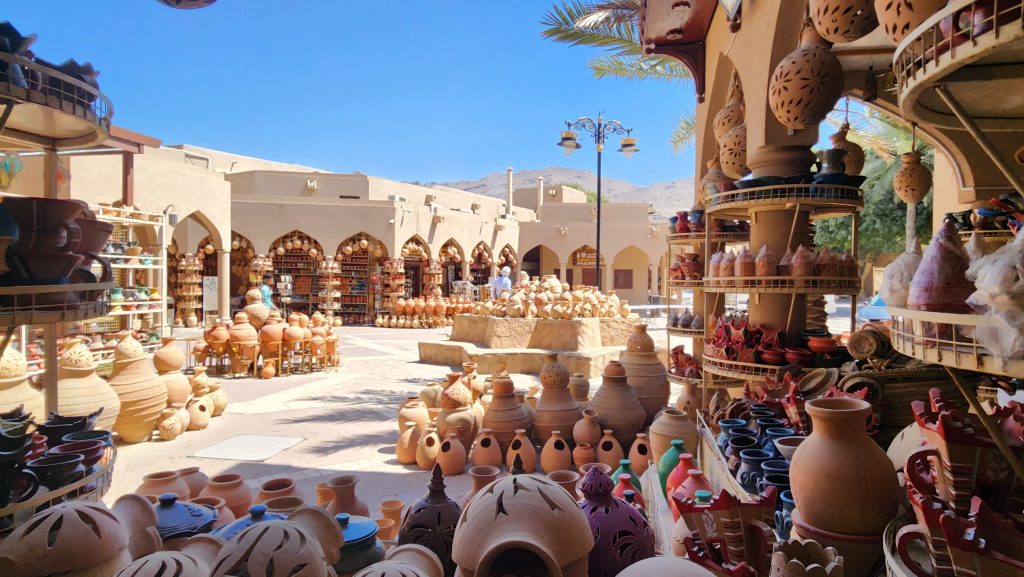
In the heart of Nizwa, were located Boutique hotels, that provided stunning views of the fort and souq. Evening walks along the renovated Al Aqr Nizwa wall, filled with the scent of blooming lemon trees, created a peaceful experience.
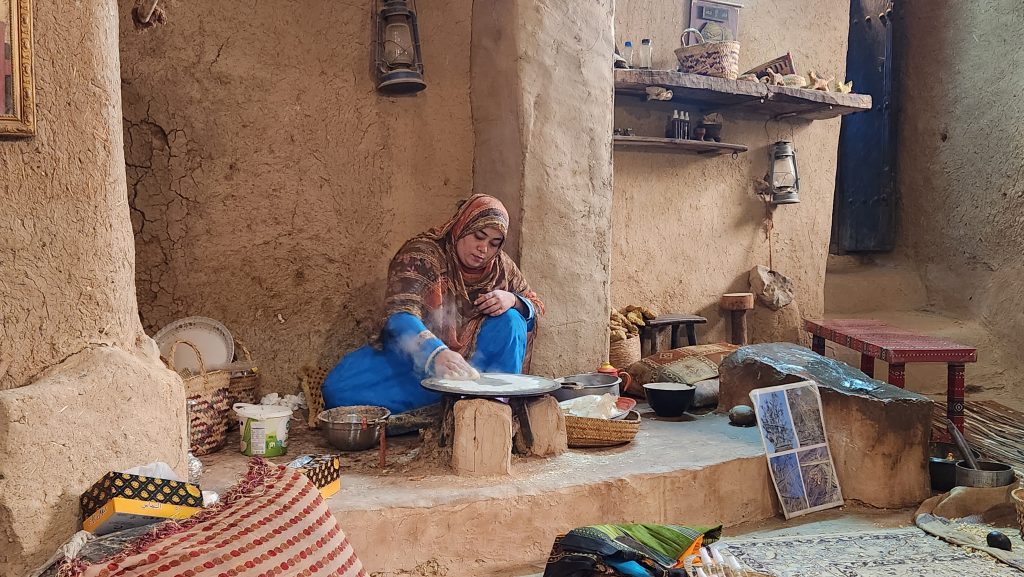
Our journey continued to Al Hamra, home to Bait Al Safah, a living history museum. Inside a restored mud-brick home, local women demonstrated traditional crafts – grinding coffee beans by hand, baking bread over an open fire, and making Omani herbal remedies.
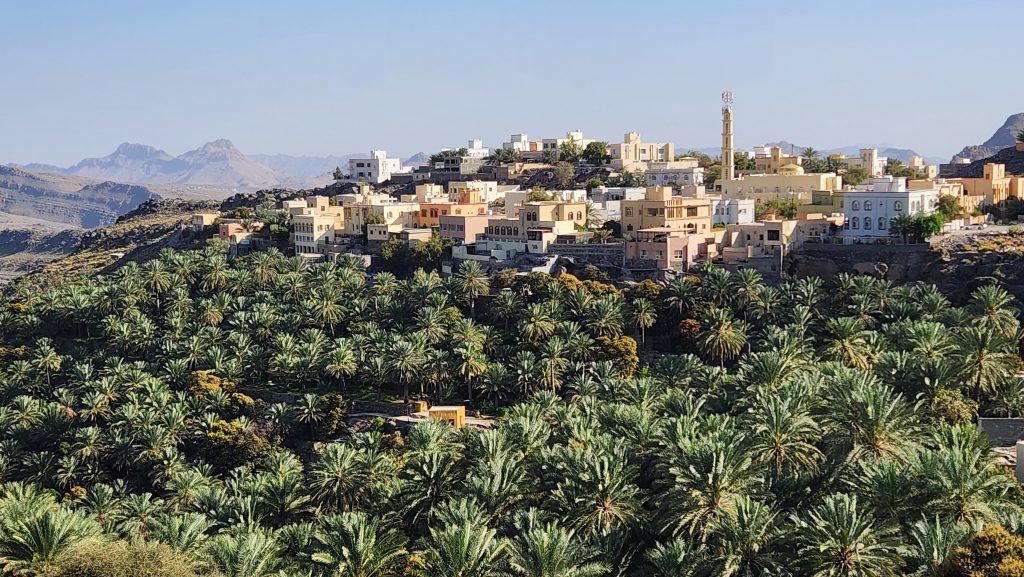
Nearby, in Misfat Al Abriyeen, villagers still farm using ancient falaj irrigation channels and harvest honey from beehives made in the hollowed-out trunk of a palm tree, which gives it a distinctive flavor.
Sharqiya Sands (Wahiba Sands) – Life in the Desert
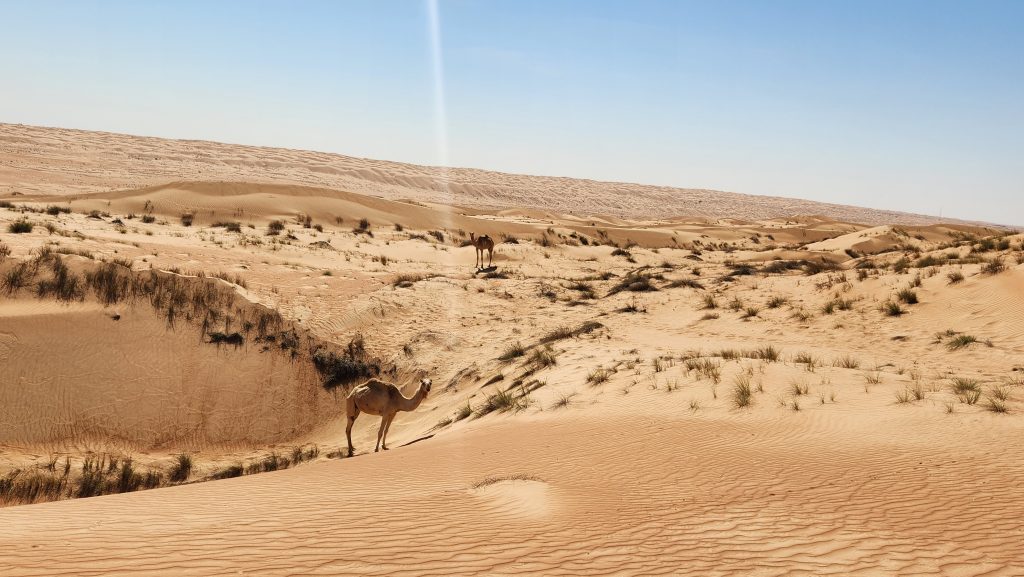
Our journey continued to the vast dunes of Sharqiya Sands, also known as Wahiba Sands, named after the Bani Wahiba tribe. The landscape was mesmerizing – rolling dunes in shades of burnt orange and beige, with camels grazing on desert shrubs. Small villages dotted the region, where children ran barefoot, enthusiastically waving and attempting to communicate with a mix of Arabic and broken English. Their excitement and warmth transcended language barriers.
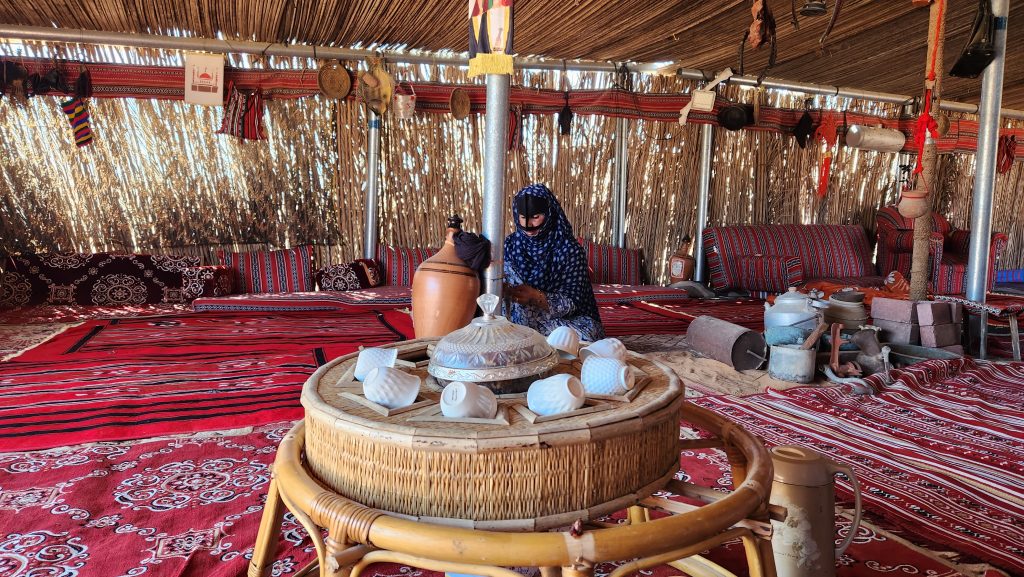
Spending time with the Bedouin community provided insight into a way of life that balances tradition with modernity. We were lucky to share an iftar meal, with a Wahiba tribe family who welcomed us with seafood biryani and lokaimat. Many Bedouins now split their time between desert camps and more urban settings but continue to herd camels, craft handmade goods, and uphold their heritage. Camel racing, a cultural tradition dating back centuries, remains an integral part of Bedouin life. In Al Ghabi village, visitors can witness local camel races, a thrilling event held every Sunday.
What to Know About Visiting Oman During Ramadan and Beyond
- Fewer travelers, allowing for a more relaxed experience
- Easy access to historic sites without crowds
- More opportunities to interact with locals and observe traditions
- Lower hotel rates, with luxury accommodations available at discounted prices
- Special iftar buffets showcasing seasonal and traditional dishes
- Adjusted business hours require more planning
- Limited dining options during the day, though takeaway meals are available
- Internet service can be unreliable in some areas
- Some ATMs may not accept foreign cards – NBO Bank ATMs are the most reliable for U.S. travelers.
Must-Try Specialties of Oman
- Biryani – A rice dish made with spiced meat, typically chicken, lamb, camel, or fish often accompanied by raisins and fried onions.
- Shuwa – Slow-cooked lamb or goat marinated with a blend of spices, traditionally cooked underground for a tender, flavorful result.
- Mutahfy – A dish of marinated meat, often chicken or lamb, cooked on skewers over an open flame, similar to kebabs.
- Machboos – A spiced rice dish, typically made with chicken or fish, cooked with a blend of aromatic spices and vegetables.
- Lokaimat – Sweet, deep-fried dough balls drizzled with syrup, often enjoyed during Ramadan.
- Karak Tea – spiced tea made with strong black tea, condensed milk, and a blend of cardamom and saffron.
- Omani Coffee – A traditional coffee brewed with spices like cardamom and saffron, often served in small cups with dates.
Planning a Journey to Oman During Ramadan
Visiting Oman during Ramadan provides a distinguished perspective on the country. The balance between quiet daytime hours and lively nights creates an unforgettable travel experience. With thoughtful planning – and guidance from a travel specialist at MIR – Ramadan can be one of the most rewarding times to explore Oman.
Want to craft your journey to Oman?






